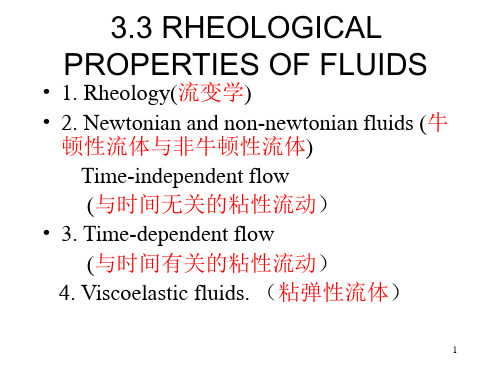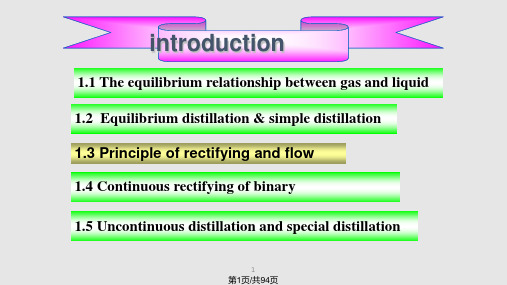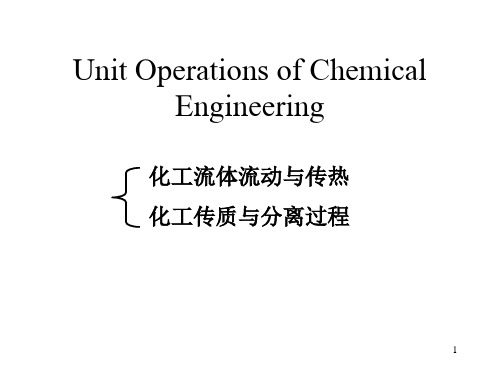化工原理课程(全英文)教学课件 7
合集下载
天大化工原理-英文版课件-Chapter 3-22流变学简介

13
d u v dy
momentum flux = (momentum diffusivity) x (momentum concentration gradient)
14
3. Viscosities of gases and liquids
viscosity = f (temperature, molecular structure, pressure)
1
3.3 RHEOLOGICAL PROPERTIES OF FLUIDS
3. Time-dependent flow
• Thixotropic(触变性) liquids break down under continued shear and on mixing give lower shear stress for a given shear rate; that is, their apparent viscosity decreases with time.
18
• Liquid mixture: • For unassociated liquid mixture
lg m xi lg i
•xi : molar fraction of i component in the mixture
19
Magnitude of viscosity •Liquid :
4
• In this course, only Newtonian fluid will be discussed.
5
3.4 VISCOSITY黏度
• • • • 1. Concept of viscosity 2. Viscosity and momentum flux 3. Viscosities of gases and liquids 4. Kinematic viscosity.
化工原理英文教材传质分离过程Mass Transfer and Separation Processes

14
•How to separate a solution of salt and water?
(Problem for producing fresh water from the sea.) (1)Supply heat and boil water off; (2)Supply refrigeration and freeze out pure ice; (3)Pump the water to a higher pressure and force it through a thin solid membrane that will let water through preferentially to salt (reverse osmosis)反渗透.
•Thinking (introspection): Many environmental pollution problems are caused by separation itself?
Why? How to solve this problem?
13
3. Definition of Separation Processes
Product Streams (different in composition, at least 2 streams)
19
Example: Distillation Fractionating
column
Feed
Overhead product
Bottom product
20
•The separation is caused by the addition of a separating agent). •separating agent: matter or energy •Usually the separating agent will cause the formation of a second phase of matter. • •Separation methods(mass transfer between two immiscible phases):
•How to separate a solution of salt and water?
(Problem for producing fresh water from the sea.) (1)Supply heat and boil water off; (2)Supply refrigeration and freeze out pure ice; (3)Pump the water to a higher pressure and force it through a thin solid membrane that will let water through preferentially to salt (reverse osmosis)反渗透.
•Thinking (introspection): Many environmental pollution problems are caused by separation itself?
Why? How to solve this problem?
13
3. Definition of Separation Processes
Product Streams (different in composition, at least 2 streams)
19
Example: Distillation Fractionating
column
Feed
Overhead product
Bottom product
20
•The separation is caused by the addition of a separating agent). •separating agent: matter or energy •Usually the separating agent will cause the formation of a second phase of matter. • •Separation methods(mass transfer between two immiscible phases):
化工原理精馏英文PPT课件

component
15
第15页/共94页
• Heat balance(te—equilibrium temperature of separator)
ignoring the heat loss
• The equilibrium relationship(ideal system)
16
第16页/共94页
• 1.3.1 Principle of rectifying
Partial vaporizing and condensing several times Basic principle of the fraction distillation: the liquid mixture can separate completely through partially vaporizing and condensing several times.
• High-pressure, Atmospheric, Reduced distillation
3
第3页/共94页
1.1 The equilibrium relationship between gas a•n1.d1.1liTqhueiiddeal system
• (a) The liquid is ideal solution, following Raoult`s law (拉乌尔定律).
When the total pressure is not high, the gas is the ideal gas, the equilibrium constitution of gas is
10
第10页/共94页
1.1.3 Volatility and relative volatility
15
第15页/共94页
• Heat balance(te—equilibrium temperature of separator)
ignoring the heat loss
• The equilibrium relationship(ideal system)
16
第16页/共94页
• 1.3.1 Principle of rectifying
Partial vaporizing and condensing several times Basic principle of the fraction distillation: the liquid mixture can separate completely through partially vaporizing and condensing several times.
• High-pressure, Atmospheric, Reduced distillation
3
第3页/共94页
1.1 The equilibrium relationship between gas a•n1.d1.1liTqhueiiddeal system
• (a) The liquid is ideal solution, following Raoult`s law (拉乌尔定律).
When the total pressure is not high, the gas is the ideal gas, the equilibrium constitution of gas is
10
第10页/共94页
1.1.3 Volatility and relative volatility
天大化工原理-英文版课件-review-2345-11Fluid mechanics

Review for Chapter 2,3,4,5 Fluid mechanics
• I. Fluid statics and its application • II. Fluid dynamics and its application
1
I. Fluid statics and its application
7
• 4.3 Measurement of liquid level • 4.4 Liquid seal of equipment
8
II. Fluid dynamics and its application
• • • • • 1. Potential flow and viscous flow 2.Viscosity of fluid 3. Rheological properties of fluids 4. Laminar flow and turbulent flow 5. Boundary layer content of chapter 3
27
2. Compound pipes in parallel • (a)
hfAB hf 1 hf 2
J/kg
q q1 q2
28
• (b)
pB
gZB
BVB2
2
h fB
pC
gZC
CVC2
2
h fC
q qB qC
29
• 5.6. A liquid with a specific gravity of 2.6 and a viscosity of 2.0 cP flows through a smooth pipe of unknown diameter, resulting in a pressure drop of 0.183 lbf/in.2 for 1.73 mi(英里,1km = 0.62137mi). What is the pipe diameter in inches if the mass rate of flow is 7,000 lb/h?
• I. Fluid statics and its application • II. Fluid dynamics and its application
1
I. Fluid statics and its application
7
• 4.3 Measurement of liquid level • 4.4 Liquid seal of equipment
8
II. Fluid dynamics and its application
• • • • • 1. Potential flow and viscous flow 2.Viscosity of fluid 3. Rheological properties of fluids 4. Laminar flow and turbulent flow 5. Boundary layer content of chapter 3
27
2. Compound pipes in parallel • (a)
hfAB hf 1 hf 2
J/kg
q q1 q2
28
• (b)
pB
gZB
BVB2
2
h fB
pC
gZC
CVC2
2
h fC
q qB qC
29
• 5.6. A liquid with a specific gravity of 2.6 and a viscosity of 2.0 cP flows through a smooth pipe of unknown diameter, resulting in a pressure drop of 0.183 lbf/in.2 for 1.73 mi(英里,1km = 0.62137mi). What is the pipe diameter in inches if the mass rate of flow is 7,000 lb/h?
天大化工原理-英文版课件-Chapter 1-11Definitions and Principles

18
4. Course objectives
• Understand the basic principles of and equipment of the unit operations. • Include designing or selection of devices. operatioroubleshooting of various unit operations.
• The international steam table calorie (calIT), used in heat power engineering, is defined by • 1 calIT=4.1868*×107 ergs = 4.1868* J (1.22)
25
• The standard gravity acceleration
gn 980.665cm / s
2
26
3. FPS Units
• The standard for mass is the avoirdupois pound (lb), • 1 lb = 0.45359237* kg (1.26) • The standard for length is the inch (in.), • 1 ft= 12× 2.54×10–2m= 0.3048* m (1.27) • The standard for time remains the second (s). • The thermodynamic temperature scale is called the Rankine scale,
9
1.1 UNIT OPERATIONS
• • • • 1. Unit operations 2. Classification of unit operations 3. Course description 4. Course objectives
4. Course objectives
• Understand the basic principles of and equipment of the unit operations. • Include designing or selection of devices. operatioroubleshooting of various unit operations.
• The international steam table calorie (calIT), used in heat power engineering, is defined by • 1 calIT=4.1868*×107 ergs = 4.1868* J (1.22)
25
• The standard gravity acceleration
gn 980.665cm / s
2
26
3. FPS Units
• The standard for mass is the avoirdupois pound (lb), • 1 lb = 0.45359237* kg (1.26) • The standard for length is the inch (in.), • 1 ft= 12× 2.54×10–2m= 0.3048* m (1.27) • The standard for time remains the second (s). • The thermodynamic temperature scale is called the Rankine scale,
9
1.1 UNIT OPERATIONS
• • • • 1. Unit operations 2. Classification of unit operations 3. Course description 4. Course objectives
化工原理学培训(英文版)(ppt 12页)

Final Exam for theory course Participation (including attendance,
Assignments) and Midterm Exam) Experiment grade based on test and
experimental behavior as well as report.
3 Third period: from 1950-1960, Transport Phenomena appeared.
4 Fourth period: in 1970s, Knowledge exposition, many subjects joined together. Lots of new subjects appeared, such as environmental chemical engineering, biochemical engineering, energy chemical engineering.
Unit Operation Of Chemical Engineering
Fluid Mechanics and Heat Transfer来自Introduction
About the Courses and time scheduling Lecturing (theory): 14 weeks, 4 classes each week
5 Fifth period: from 1980s-1990s, MIT suggested Integrated chemical engineering, and regressive engineering.
6 Sixth period: in the 21st century. Green chemistry, biochemorphic Chem. Eng. ideas was put forward.
Assignments) and Midterm Exam) Experiment grade based on test and
experimental behavior as well as report.
3 Third period: from 1950-1960, Transport Phenomena appeared.
4 Fourth period: in 1970s, Knowledge exposition, many subjects joined together. Lots of new subjects appeared, such as environmental chemical engineering, biochemical engineering, energy chemical engineering.
Unit Operation Of Chemical Engineering
Fluid Mechanics and Heat Transfer来自Introduction
About the Courses and time scheduling Lecturing (theory): 14 weeks, 4 classes each week
5 Fifth period: from 1980s-1990s, MIT suggested Integrated chemical engineering, and regressive engineering.
6 Sixth period: in the 21st century. Green chemistry, biochemorphic Chem. Eng. ideas was put forward.
化工原理Principles of Chemical Engineering
新乡学院化工原理精品课程
参考书目
• 《化工原理》(上、下) 社,1999。 • 化工原理(上、下册),第二版,陈敏恒编,化学 工业出版社,2000年。(或2006年,第三版) • 《化工原理》,谭天恩主编,化学工业出版社,第 三版,2006。 姚玉英 天津大学出版
新乡学院化工原理精品课程
化工原理
Principles of Chemical Engineering
新乡学院化工原理精品课程
0 绪论
0.1化工过程与单元操作 化工过程与单元操作 0.2物料恒算与能量恒算 物料恒算与能量恒算 0.3 单位制与单位换算
新乡学院化工原理精品课程
0 绪论
化工原理课程主要研究化工过程中各种单元操作 0.1 化工过程与单元操作 0.1.1 化工过程
∑Q = ∑Q
I
O
+ QL
(0 − 1)
注意:作热量衡算时,由于焓是相对值,与温 度基准有关,故应说明基准温度。习惯上选0℃ 为基温,并规定0℃时液态的焓为零。
新乡学院化工原理精品课程
0.3 单位制与单位换算
一、基本单位与导出单位 基本单位:选择几个独立的物理量,根据方便原 则规定单位; 导出单位:由有关基本单位组合而成。 单位制度的不同,在于所规定的基本单位及单位 大小不同。
新乡学院化工原理精品课程
新乡学院化工原理精品课程
新乡学院化工原理精品课程
0.1.2 单元操作(Unit Operation) 单元操作( ) 1 、 单元操作:在化工生产中,具有共同物理操作原 理和设备的过程。 2、单元操作分类: (1)遵循流体动力学基本规律:动量传递 (2)遵循热量传递基本规律:热量传递 (3)遵循质量传递基本规律:质量传递
化工原理完整教材课件
(下标"0"表示标准状态)
(1-3a)
1.2.1.2 气体的密度
或
1.2.2 流体的压强及其特性
垂直作用于单位面积上的表面力称为流体的静压强,简称压强。流体的压强具有点特性。工程上习惯上将压强称之为压力。 在SI中,压强的单位是帕斯卡,以Pa表示。但习惯上还采用其它单位,它们之间的换算关系为: (2) 压强的基准 压强有不同的计量基准:绝对压强、表压强、真空度。
1.1.2 流体流动的考察方法
流体是由大量的彼此间有一定间隙的单个分子所组成。在物理化学(气体分子运动论)重要考察单个分子的微观运动,分子的运动是随机的、不规则的混乱运动。这种考察方法认为流体是不连续的介质,所需处理的运动是一种随机的运动,问题将非常复杂。 1.1.2.1 连续性假设(Continuum hypotheses) 在化工原理中研究流体在静止和流动状态下的规律性时,常将流体视为由无数质点组成的连续介质。 连续性假设:假定流体是有大量质点组成、彼此间没有间隙、完全充满所占空间连续介质,流体的物性及运动参数在空间作连续分布,从而可以使用连续函数的数学工具加以描述。
图1-2压强的基准和量度
1.2.1.2 流体压强的特性
流体压强具有以下两个重要特性: ①流体压力处处与它的作用面垂直,并且总是指向流体的作用面; ②流体中任一点压力的大小与所选定的作用面在空间的方位无关。
熟悉压力的各种计量单位与基准及换算关系,对于以后的学习和实际工程计算是十分重要的。
2 本章应掌握的内容 (1) 流体静力学基本方程式的应用; (2) 连续性方程、柏努利方程的物理意义、适用条件、解题要点; (3) 两种流型的比较和工程处理方法; (4) 流动阻力的计算; (5) 管路计算。 3. 本章学时安排 授课14学时,习题课4学时。
化工原理英文教材-传质与分离部分chapter7
6
3. Thermodynamic relationships
1)Equilibrium ratio ( or equilibrium constant or K
yA KA xA
Where KA=Equilibrium ratio KA AB yA=mole fraction of component A in vapor KB xA= mole fraction of component A in liquid
Chapter 7 Equilibrium rela
1
1. Phase Rule
•F =
C–Φ+2 F = number of degrees of freedom, or variance C= number of components Φ= number of phases 2 —— only temperature and pressure may affect th e.g.: In systems of two components, C=2;Φ=2; therefore, F = 2 - 2 + 2 = 2
The above equations can be rearranged give
(重新整理)
to
16
AB x A yA 1 ( AB 1) x A
Let xA=x;yA=y:
Phase equilibrium equation:
x y 1 ( 1) x
The above equation is used to express the concentration of component A in the vapor as a function of its concentration in the liquid and relative volatility.表示在总压一定时,气液平衡时
化工原理课程(全英文)教学课件 11
Developed Head ������ = ������������ ������, unit m
12
Station a @ suction connection Station b @ discharge connection
© 2015 Yanwei Wang
Power Requirement & Motor Efficiency
������������ = ������������ − ������������������ = ������������������
������������ = Net work done to unit mass of fluid
������������ = Work done by the pump per unit mass of fluid ������������������ = Total friction in the pump per unit mass of fluid ������ = Pump efficiency ������ = Mass flow rate Shaft power = ������ = ������������������
Date: April 9, 2015
Chapter 2 Transportation of Fluids
Pipe, Fittings, and Valves (pp. 82-88)
Fluid-Moving Machinery (流体输送机械)
− Pumps (pp. 88-93)
− Positive-Displacement Pumps (pp.93-95)
7
© 2015 Yanwei Wang
- 1、下载文档前请自行甄别文档内容的完整性,平台不提供额外的编辑、内容补充、找答案等附加服务。
- 2、"仅部分预览"的文档,不可在线预览部分如存在完整性等问题,可反馈申请退款(可完整预览的文档不适用该条件!)。
- 3、如文档侵犯您的权益,请联系客服反馈,我们会尽快为您处理(人工客服工作时间:9:00-18:30)。
������������ ������������ = ������������ ������������
⑩
������ = ������ + ������������
������������ ������������
where ������������ is called the eddy viscosity. Fluid viscosities (������) are true properties of the fluid, and can be measured on isolated samples of the fluid; eddy viscosity (������������ ) depends on both the fluid and also the fluid velocity and system geometry and is sensitive to location in the turbulent field and the
������������������ inertial force ������������ = = ������ Viscous force
Parabolic velocity distribution, with
������ = ������������,������������������ ������ Shear stress is linear in radial distance Volumetric flow rate is given by the Hagen-Poiseuille equation The Fanning friction factor is given by ������ = ������������ ������������ ℎ������������
������������������ 4 ������������������4 ������ = = 128������������ 8������������
© 2015 Yanwei Wang
Turbulent flow in pipes
The onset of turbulence: The top panel shows an image of a single “puff” (localized turbulent patches embedded in the surrounding laminar flow) structure, at a Reynolds number of 2000 (just below the onset of turbulence). As the Reynolds number increases, the spatial scale of the structure decreases.
6 © 2015 Yanwei Wang
Interim summary on turbulent flow (1/4)
① Occurs at high Re (Re > 4000 for flow in a pipe) ② In Reynolds experiment, dye mixes rapidly and completely – Hence, turbulent flow is important for mixing. ③ Path of fluid particles completely irregular, tends to produce chaotic eddies, vortices and other flow instabilities. ④ Deviating velocities: Average motion is in the direction of
the flow, but there are rapid fluctuations in local velocities,
often characterized by statistical analysis. ⑤ Most common type of flow, but Mathematical analysis very
Layer flow with free surface
Incompressible flow in pipes and channels Lamw)
2 © 2015 Yanwei Wang
Homework (HW-6)
HW6-1: Reynolds number and transition from laminar to turbulent flow: (a) airflow and (b) water flow. HW6-2: Incompressible flow through an inclined pipe
5
Δ������������2 ������ ������������ ������ = 1− 4������������ ������ ������������������ ������ = Δ������ 2������
2
∆������������ 4 ������ ������ ������ 2 ������ ������ 2 = = ������������ = 4������ = ������ ������ ������ ������ ������ 2 ������ 2
2100 and 4000 a transition region
is found where the flow may be either laminar or turbulent, The Onset of Turbulence in Pipe Flow. ������ is the mean lifetime of a puff before decaying or splitting. Avila, K. at al., Science, 333, pp.192 (2011)
local values of the scale and intensity of turbulence. Difficult to
determine in practice.
9
© 2015 Yanwei Wang
Interim summary on Turbulence (4/4)
The transition from laminar to turbulent flow may occur over a wide range of Re values. In a pipe, flow is always laminar at Re < 2100, Under ordinary conditions, the flow in a pipe or tube is turbulent at Re > 4000. Between
Sketch for HW6-2
3 © 2015 Yanwei Wang
Today’s topic
Date: March 23, 2015
Pages 29-33 and 52-56 of textbook
Turbulent flow in pipes and channels
Velocity profile
Pages 25-29 & 43-56 of textbook
Types of fluid flow and Reynolds number
Reynolds experiment Laminar vs. Turbulent flow Reynolds number Macroscopic momentum balances
4 © 2015 Yanwei Wang
Summary of Laminar flow in pipes
Poiseuille flow, Re < 2100
Total shear stress is the viscous stress given by Newton’s law of viscosity
Relation between ������������������������ and ������
Effect of roughness Moody’s chart
Boundary layers
Understand the concept
Be able to explain Figs. 1.8, 1.9, 1.10, and 1.11
Fall Semester, 2014
Basic Principles of Chemical
Engineering Processes
Lecture 7
Yanwei Wang (王衍伟) Email: ywwang@
© 2015 Yanwei Wang
Previous Lecture
8
© 2015 Yanwei Wang
Interim summary on Turbulence (3/4)
⑨ The total shear stress in a turbulent fluid is the sum of the viscous stress and the turbulent stress, ������������
difficult – hence experimental measures are used.
7
© 2015 Yanwei Wang
Interim summary on Turbulence (2/4)
⑥ Turbulent flow consists of eddies of various sizes, but even the smallest eddies have diameter 10 to 100 μm, so turbulent flow is not a molecular phenomenon. ⑦ The turbulent energy cascade: The energy by external forces excites the largest possible eddies and is gradually passed to ever smaller eddies, all the way to a minimum scale where this energy is ultimately dissipated to heat by viscous dissipation.
